Yue Xiao
Pinching-Antenna-Assisted Index Modulation: Channel Modeling, Transceiver Design, and Performance Analysis
Jul 03, 2025Abstract:In this paper, a novel pinching-antenna assisted index modulation (PA-IM) scheme is proposed for improving the spectral efficiency without increasing the hardware complexity, where the information bits are conveyed not only by the conventional M-ary quadrature amplitude modulation (QAM) symbols but also by the indices of pinching antenna (PA) position patterns. To realize the full potential of this scheme, this paper focuses on the comprehensive transceiver design, addressing key challenges in signal detection at the receiver and performance optimization at thetransmitter. First, a comprehensive channel model is formulated for this architecture, which sophisticatedly integrates the deterministic in-waveguide propagation effects with the stochastic nature of wireless channels, including both largescale path loss and small-scale fading. Next, to overcome the prohibitive complexity of optimal maximum likelihood (ML) detection, a low-complexity box-optimized sphere decoding (BOSD) algorithm is designed, which adaptively prunes the search space whilst preserving optimal ML performance. Furthermore, an analytical upper bound on the bit error rate (BER) is derived and validated by the simulations. Moreover, a new transmit precoding method is designed using manifold optimization, which minimizes the BER by jointly optimizing the complex-valued precoding coefficients across the waveguides for the sake of maximizing the minimum Euclidean distance of all received signal points. Finally, the simulation results demonstrate that the proposed PA-IM scheme attains a significant performance gain over its conventional counterparts and that the overall BER of the pinching-antenna system is substantially improved by the proposed precoding design.
Fluid Aerial Networks: UAV Rotation for Inter-Cell Interference Mitigation
Jul 02, 2025Abstract:With the rapid development of aerial infrastructure, unmanned aerial vehicles (UAVs) that function as aerial base stations (ABSs) extend terrestrial network services into the sky, enabling on-demand connectivity and enhancing emergency communication capabilities in cellular networks by leveraging the flexibility and mobility of UAVs. In such a UAV-assisted network, this paper investigates position-based beamforming between ABSs and ground users (GUs). To mitigate inter-cell interference, we propose a novel fluid aerial network that leverages ABS rotation to increase multi-cell capacity and overall network efficiency. Specifically, considering the line-of-sight channel model, the spatial beamforming weights are determined by the orientation angles of the GUs. In this direction, we examine the beamforming gain of a two-dimensional multiple-input multiple-output (MIMO) array at various ground positions, revealing that ABS rotation significantly affects multi-user channel correlation and inter-cell interference. Based on these findings, we propose an alternative low-complexity algorithm to design the optimal rotation angle for ABSs, aiming to reduce inter-cell interference and thus maximize the sum rate of multi-cell systems. In simulations, exhaustive search serves as a benchmark to validate the optimization performance of the proposed sequential ABS rotation scheme. Moreover, simulation results demonstrate that, in interference-limited regions, the proposed ABS rotation paradigm can significantly reduce inter-cell interference in terrestrial networks and improve the multi-cell sum rate by approximately 10\% compared to fixed-direction ABSs without rotation.
Cognitive-Radio Functionality: A Novel Configuration for STAR-RIS assisted RSMA Networks
May 30, 2025Abstract:Cognitive radio rate-splitting multiple access (CR-RSMA) has emerged as a promising multiple access framework that can efficiently manage interference and adapt dynamically to heterogeneous quality-of-service (QoS) requirements. To effectively support such demanding access schemes, programmable wireless environments have attracted considerable attention, especially through simultaneously transmitting and reflecting reconfigurable intelligent surfaces (STAR-RISs), which can enable full-space control of signal propagation in asymmetric user deployments. In this paper, we propose the cognitive radio (CR) functionality for STAR-RIS-assisted CR-RSMA systems, leveraging the unique capability of the STAR-RIS to combine element and power splitting for adaptive control of transmission and reflection in CR scenarios. Specifically, the proposed CR functionality partitions the STAR-RIS into two regions independently controlling the transmission and reflection of signals, simultaneously ensuring the required QoS for the primary user and enhancing the performance of the secondary user. To accurately characterize the system performance, we derive analytical expressions for the ergodic rate of the secondary user and the outage rate of the primary user under Nakagami-m fading. Finally, simulation results show that the proposed approach effectively manages interference, guarantees the QoS of the primary user, and significantly improves the throughput of the secondary user, highlighting STAR-RIS as an efficient solution for CR-RSMA-based services.
ACSNet: A Deep Neural Network for Compound GNSS Jamming Signal Classification
Apr 15, 2025



Abstract:In the global navigation satellite system (GNSS), identifying not only single but also compound jamming signals is crucial for ensuring reliable navigation and positioning, particularly in future wireless communication scenarios such as the space-air-ground integrated network (SAGIN). However, conventional techniques often struggle with low recognition accuracy and high computational complexity, especially under low jamming-to-noise ratio (JNR) conditions. To overcome the challenge of accurately identifying compound jamming signals embedded within GNSS signals, we propose ACSNet, a novel convolutional neural network designed specifically for this purpose. Unlike traditional methods that tend to exhibit lower accuracy and higher computational demands, particularly in low JNR environments, ACSNet addresses these issues by integrating asymmetric convolution blocks, which enhance its sensitivity to subtle signal variations. Simulations demonstrate that ACSNet significantly improves accuracy in low JNR regions and shows robust resilience to power ratio (PR) variations, confirming its effectiveness and efficiency for practical GNSS interference management applications.
Hybrid Beamforming for RIS-Assisted Multiuser Fluid Antenna Systems
Apr 12, 2025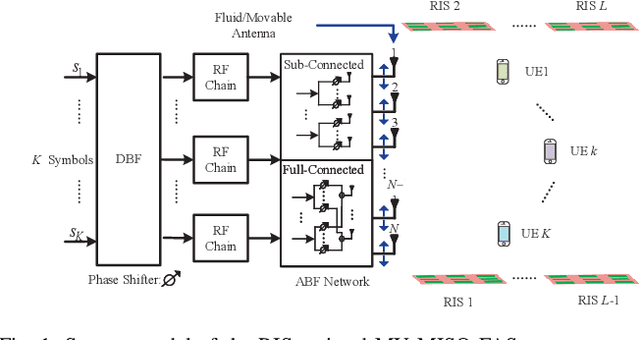
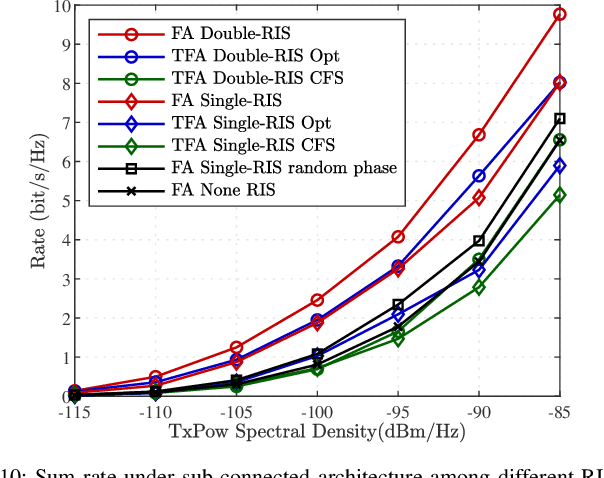
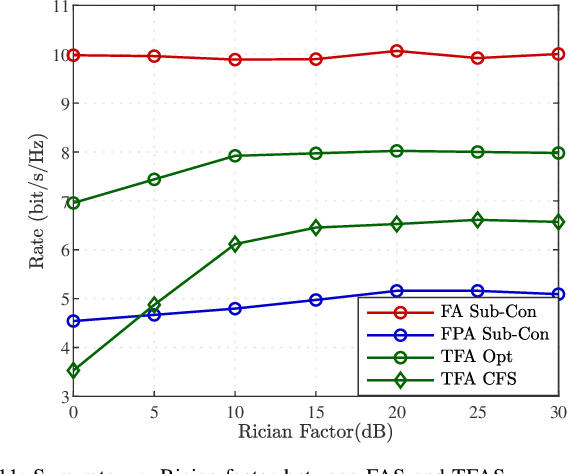
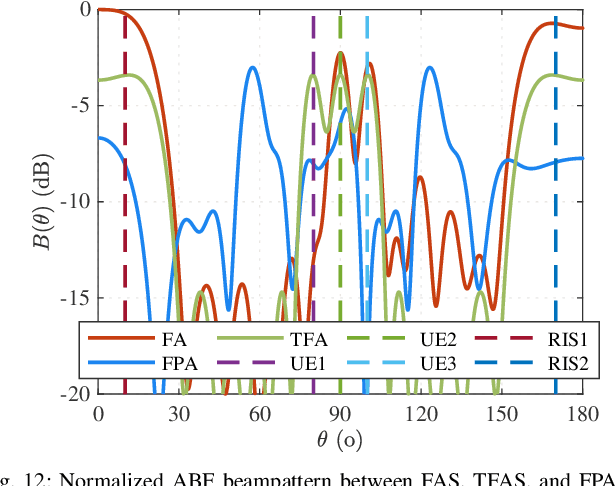
Abstract:Recent advances in reconfigurable antennas have led to the new concept of the fluid antenna system (FAS) for shape and position flexibility, as another degree of freedom for wireless communication enhancement. This paper explores the integration of a transmit FAS array for hybrid beamforming (HBF) into a reconfigurable intelligent surface (RIS)-assisted communication architecture for multiuser communications in the downlink, corresponding to the downlink RIS-assisted multiuser multiple-input single-output (MISO) FAS model (Tx RIS-assisted-MISO-FAS). By considering Rician channel fading, we formulate a sum-rate maximization optimization problem to alternately optimize the HBF matrix, the RIS phase-shift matrix, and the FAS position. Due to the strong coupling of multiple optimization variables, the multi-fractional summation in the sum-rate expression, the modulus-1 limitation of analog phase shifters and RIS, and the antenna position variables appearing in the exponent, this problem is highly non-convex, which is addressed through the block coordinate descent (BCD) framework in conjunction with semidefinite relaxation (SDR) and majorization-minimization (MM) methods. To reduce the computational complexity, we then propose a low-complexity grating-lobe (GL)-based telescopic-FAS (TFA) with multiple delicately deployed RISs under the sub-connected HBF architecture and the line-of-sight (LoS)-dominant channel condition, to allow closed-form solutions for the HBF and TFA position. Our simulation results illustrate that the former optimization scheme significantly enhances the achievable rate of the proposed system, while the GL-based TFA scheme also provides a considerable gain over conventional fixed-position antenna (FPA) systems, requiring statistical channel state information (CSI) only and with low computational complexity.
Optimizing Radio Access Technology Selection and Precoding in CV-Aided ISAC Systems
Oct 14, 2024Abstract:Integrated Sensing and Communication (ISAC) systems promise to revolutionize wireless networks by concurrently supporting high-resolution sensing and high-performance communication. This paper presents a novel radio access technology (RAT) selection framework that capitalizes on vision sensing from base station (BS) cameras to optimize both communication and perception capabilities within the ISAC system. Our framework strategically employs two distinct RATs, LTE and millimeter wave (mmWave), to enhance system performance. We propose a vision-based user localization method that employs a 3D detection technique to capture the spatial distribution of users within the surrounding environment. This is followed by geometric calculations to accurately determine the state of mmWave communication links between the BS and individual users. Additionally, we integrate the SlowFast model to recognize user activities, facilitating adaptive transmission rate allocation based on observed behaviors. We develop a Deep Deterministic Policy Gradient (DDPG)-based algorithm, utilizing the joint distribution of users and their activities, designed to maximize the total transmission rate for all users through joint RAT selection and precoding optimization, while adhering to constraints on sensing mutual information and minimum transmission rates. Numerical simulation results demonstrate the effectiveness of the proposed framework in dynamically adjusting resource allocation, ensuring high-quality communication under challenging conditions.
GNSS Interference Classification Using Federated Reservoir Computing
Aug 23, 2024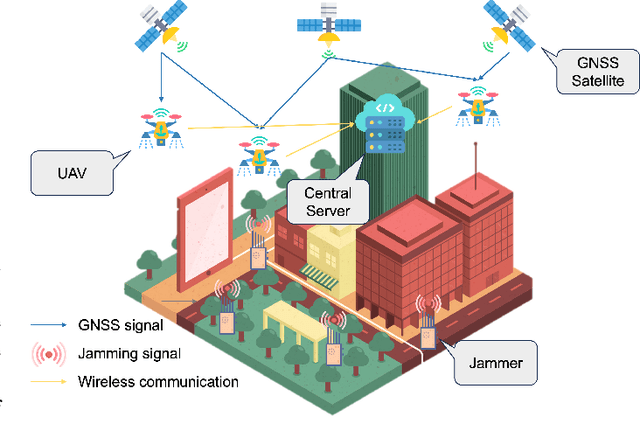
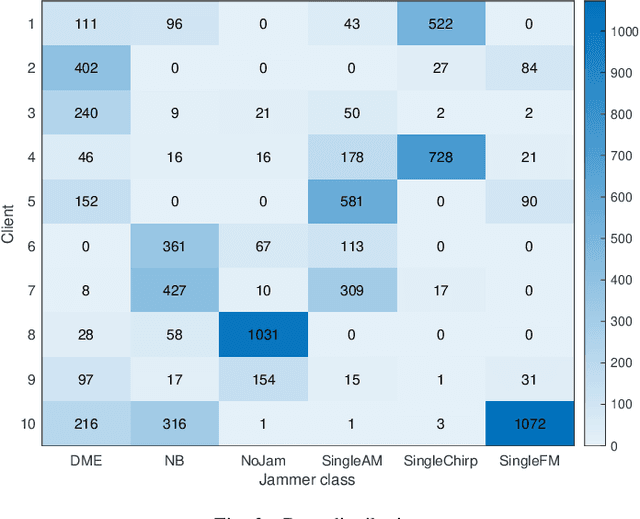


Abstract:The expanding use of Unmanned Aerial Vehicles (UAVs) in vital areas like traffic management, surveillance, and environmental monitoring highlights the need for robust communication and navigation systems. Particularly vulnerable are Global Navigation Satellite Systems (GNSS), which face a spectrum of interference and jamming threats that can significantly undermine their performance. While traditional deep learning approaches are adept at mitigating these issues, they often fall short for UAV applications due to significant computational demands and the complexities of managing large, centralized datasets. In response, this paper introduces Federated Reservoir Computing (FedRC) as a potent and efficient solution tailored to enhance interference classification in GNSS systems used by UAVs. Our experimental results demonstrate that FedRC not only achieves faster convergence but also sustains lower loss levels than traditional models, highlighting its exceptional adaptability and operational efficiency.
CA-FedRC: Codebook Adaptation via Federated Reservoir Computing in 5G NR
Jul 08, 2024Abstract:With the burgeon deployment of the fifth-generation new radio (5G NR) networks, the codebook plays a crucial role in enabling the base station (BS) to acquire the channel state information (CSI). Different 5G NR codebooks incur varying overheads and exhibit performance disparities under diverse channel conditions, necessitating codebook adaptation based on channel conditions to reduce feedback overhead while enhancing performance. However, existing methods of 5G NR codebooks adaptation require significant overhead for model training and feedback or fall short in performance. To address these limitations, this letter introduces a federated reservoir computing framework designed for efficient codebook adaptation in computationally and feedback resource-constrained mobile devices. This framework utilizes a novel series of indicators as input training data, striking an effective balance between performance and feedback overhead. Compared to conventional models, the proposed codebook adaptation via federated reservoir computing (CA-FedRC), achieves rapid convergence and significant loss reduction in both speed and accuracy. Extensive simulations under various channel conditions demonstrate that our algorithm not only reduces resource consumption of users but also accurately identifies channel types, thereby optimizing the trade-off between spectrum efficiency, computational complexity, and feedback overhead.
Federated Transfer Learning Aided Interference Classification in GNSS Signals
Jun 23, 2024Abstract:This study delves into the classification of interference signals to global navigation satellite systems (GNSS) stemming from mobile jammers such as unmanned aerial vehicles (UAVs) across diverse wireless communication zones, employing federated learning (FL) and transfer learning (TL). Specifically, we employ a neural network classifier, enhanced with FL to decentralize data processing and TL to hasten the training process, aiming to improve interference classification accuracy while preserving data privacy. Our evaluations span multiple data scenarios, incorporating both independent and identically distributed (IID) and non-identically distributed (non-IID), to gauge the performance of our approach under different interference conditions. Our results indicate an improvement of approximately $8\%$ in classification accuracy compared to basic convolutional neural network (CNN) model, accompanied by expedited convergence in networks utilizing pre-trained models. Additionally, the implementation of FL not only developed privacy but also matched the robustness of centralized learning methods, particularly under IID scenarios. Moreover, the federated averaging (FedAvg) algorithm effectively manages regional interference variability, thereby enhancing the regional communication performance indicator, $C/N_0$, by roughly $5\text{dB}\cdot \text{Hz}$ compared to isolated setups.
Sensing-Resistance-Oriented Beamforming for Privacy Protection from ISAC Devices
Apr 08, 2024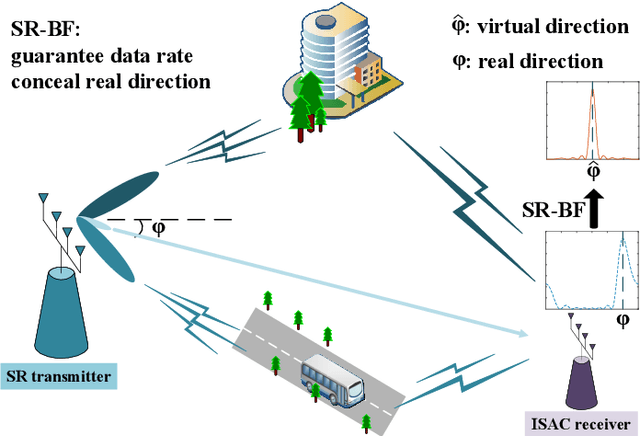
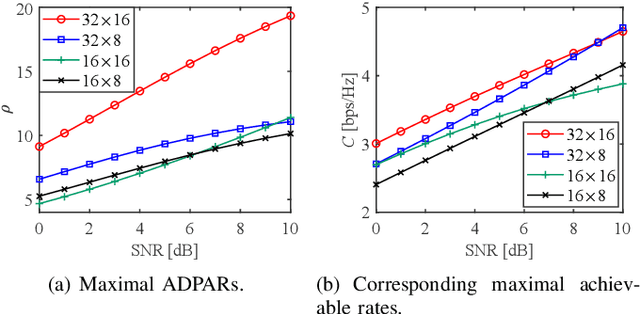
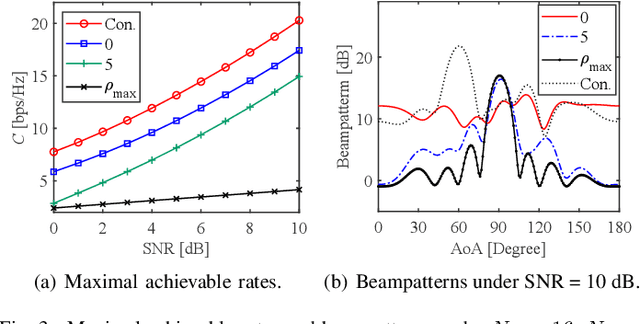
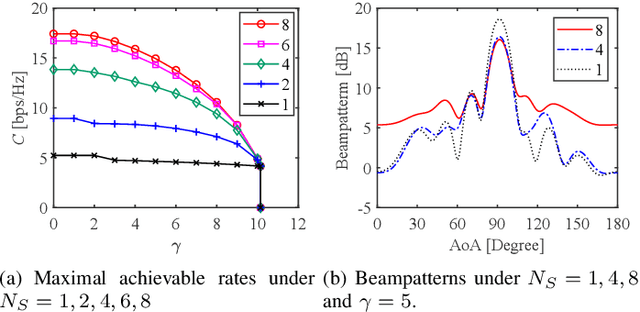
Abstract:With the evolution of integrated sensing and communication (ISAC) technology, a growing number of devices go beyond conventional communication functions with sensing abilities. Therefore, future networks are divinable to encounter new privacy concerns on sensing, such as the exposure of position information to unintended receivers. In contrast to traditional privacy preserving schemes aiming to prevent eavesdropping, this contribution conceives a novel beamforming design toward sensing resistance (SR). Specifically, we expect to guarantee the communication quality while masking the real direction of the SR transmitter during the communication. To evaluate the SR performance, a metric termed angular-domain peak-to-average ratio (ADPAR) is first defined and analyzed. Then, we resort to the null-space technique to conceal the real direction, hence to convert the optimization problem to a more tractable form. Moreover, semidefinite relaxation along with index optimization is further utilized to obtain the optimal beamformer. Finally, simulation results demonstrate the feasibility of the proposed SR-oriented beamforming design toward privacy protection from ISAC receivers.
 Add to Chrome
Add to Chrome Add to Firefox
Add to Firefox Add to Edge
Add to Edge